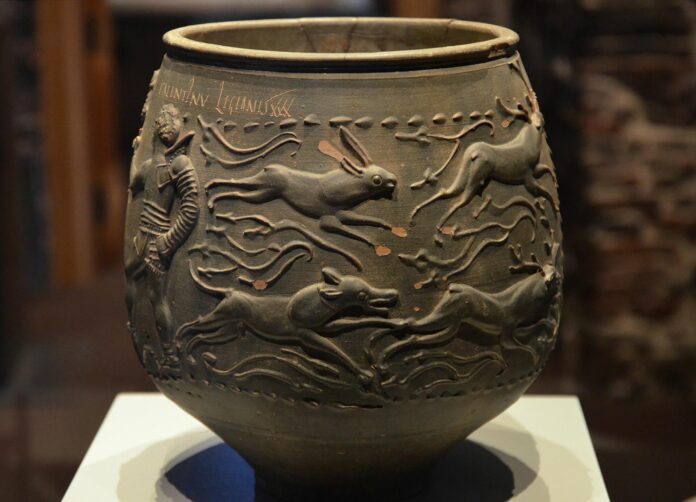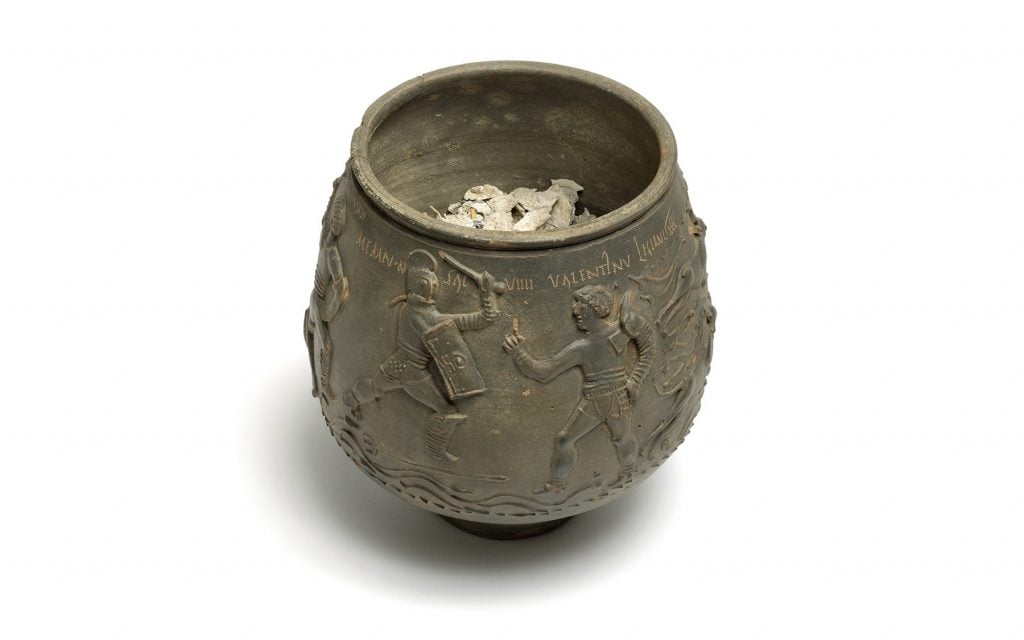Gladiatorial Combat in Roman Britain: Insights from the Colchester Vase

A new analysis of the famous Colchester vase indicates that gladiators fought in Roman Britain during the second century A.D. Vivid depictions of battling gladiators on a clay vase provide the first concrete evidence that these combatants duked it out in Roman Britain, shedding new light on the ancient sporting events that took place on the fringes of the Roman Empire.
Discovery of the Colchester Vase

The Colchester vase, discovered in a Roman-era grave in Britain in 1853, is well known to researchers. This vessel, which holds a person’s cremated remains, has puzzled historians for decades. Until recently, it was unclear whether the vase had been crafted locally or in continental Europe, where gladiator fights were common.
New Insights from Recent Studies
A forthcoming study has revealed that the vase was made with local clay as a souvenir of a specific gladiatorial match in the second century A.D. This finding offers unprecedented insight into the sporting events held in Roman Britain. The town of Colchester, where the vase was found, is located in southeast England, about 60 miles (100 kilometers) from London. Known in Roman times as Camulodunum, Colchester was a large city with a thriving pottery industry and boasted three theaters and the only chariot racetrack in Britain by the second century A.D.
Detailed Depictions of Gladiatorial Combat

The Colchester vase, measuring 9 inches (23 centimeters) tall and weighing over 2.2 pounds (1 kilogram), depicts three gladiator scenes featuring three types of combatants: human-human, human-animal, and animal-animal. In one scene, “bestiarii” (beast fighters) labeled Secundus and Mario are fighting a bear. Another scene shows Memnon and Valentinus fighting as “secutor” (chaser) and “retiarius” (net man), a fight pitting a lightly armored man against one with a trident and a net, symbolizing a fisherman and his prey. Valentinus is described as being in the 30th legion, stationed in northwestern Germany, while Memnon is noted with the Roman numerals VIIII, indicating he fought and survived nine times.
Local Craftsmanship Confirmed

The intricate decoration on the vase led researchers to initially believe it could not have been made in Britain. However, growing evidence for the pottery industry in Colchester allowed the research team to identify the vase as a locally made vessel dating to A.D. 160-200. Close examination of the inscription, previously assumed to have been created after the pot was fired, shows it was made when the clay was soft, after the decoration had been applied. John Pearce, a senior lecturer of archaeology at King’s College London, confirmed this in an email to Live Science.
The Vase as a Funerary Urn
Originally created as a commemorative cup, the vase was later repurposed as a funerary urn. The detailed replication of the gladiator scenes on the Colchester vase reflects a key moment in the proceedings. The inscription helps make this a special memento and likely echoes the promotional hype leading up to the fight, with placards parading the names of fighters.
Analysis of the Cremated Remains

Scientific analysis of the cremated bones revealed that they are the remains of a robust man older than 40 at the time of his death. His teeth indicate he did not originate from Colchester but from southwestern England or possibly beyond the British Isles. However, he was not one of the gladiators depicted on the vase. Pearce stated that there is no strong case for identifying the remains as those of a performer.
Speculations on the Deceased’s Connection to Gladiators
Steven Tuck, a professor of history and classics at Miami University in Ohio, suggested that the cremated individual could have been a fan of gladiators or a particular gladiator. The use of the gladiator vase as an urn may suggest a more personal connection. Tuck speculates that the individual may have been associated with the event in some way, possibly a retired gladiator who remained involved in the spectacle.
Conclusion
With its gladiatorial themes and locally sourced clay, the Colchester vase is a remarkable example of Roman-style games in a far-flung part of the empire. Given the lack of written descriptions of such events in Britain, the Colchester vase provides conclusive evidence that gladiatorial contests occurred there and that people took home souvenirs of their adventures. Colchester Councillor Pam Cox expressed excitement over this discovery, acknowledging the efforts of researchers who have helped uncover secrets from the vase. The Colchester vase will be featured in an exhibition on gladiators at Colchester Castle starting July 15.
Video
News
The Hanging Temple: China’s 1,500-Year-Old Cliffside Marvel of Faith and Engineering
The Hanging Temple: China’s 1,500-Year-Old Cliffside Marvel of Faith and Engineering Perched precariously on the cliffs of Mount Heng in Shanxi Province, China, the Hanging Temple, also known as Xuankong Temple, Hengshan Hanging Temple, or Hanging Monastery, is an architectural…
The Willendorf Venus: A 30,000-Year-Old Masterpiece Reveals Astonishing Secrets
The Willendorf Venus: A 30,000-Year-Old Masterpiece Reveals Astonishing Secrets The “Willendorf Venus” stands as one of the most revered archaeological treasures from the Upper Paleolithic era. Discovered in 1908 by scientist Johann Veran near Willendorf, Austria, this small yet profound…
Unveiling the Maya: Hallucinogens and Rituals Beneath the Yucatán Ball Courts
Unveiling the Maya: Hallucinogens and Rituals Beneath the Yucatán Ball Courts New archaeological research has uncovered intriguing insights into the ritual practices of the ancient Maya civilization. The focus of this study is a ceremonial offering found beneath the sediment…
Uncovering the Oldest Agricultural Machine: The Threshing Sledge’s Neolithic Origins
Uncovering the Oldest Agricultural Machine: The Threshing Sledge’s Neolithic Origins The history of agricultural innovation is a fascinating journey that spans thousands of years, and one of the earliest known agricultural machines is the threshing sledge. Recently, a groundbreaking study…
Nara’s Ancient Sword: A 1,600-Year-Old Protector Against Evil Spirits
Nara’s Ancient Sword: A 1,600-Year-Old Protector Against Evil Spirits In a remarkable discovery that has captured the attention of archaeologists and historians alike, a 7.5-foot-long iron sword was unearthed from a 1,600-year-old burial mound in Nara, Japan. This oversized weapon,…
The Inflatable Plane, Dropped Behind the Lines for Downed Pilots
Experimental The Inflatable Plane, Dropped Behind the Lines for Downed Pilots The Inflatoplane from Goodyear was an unconventional aircraft developed by the Goodyear Aircraft Company, a branch of the renowned Goodyear Tire and Rubber Company, also famed for the Goodyear…
End of content
No more pages to load











